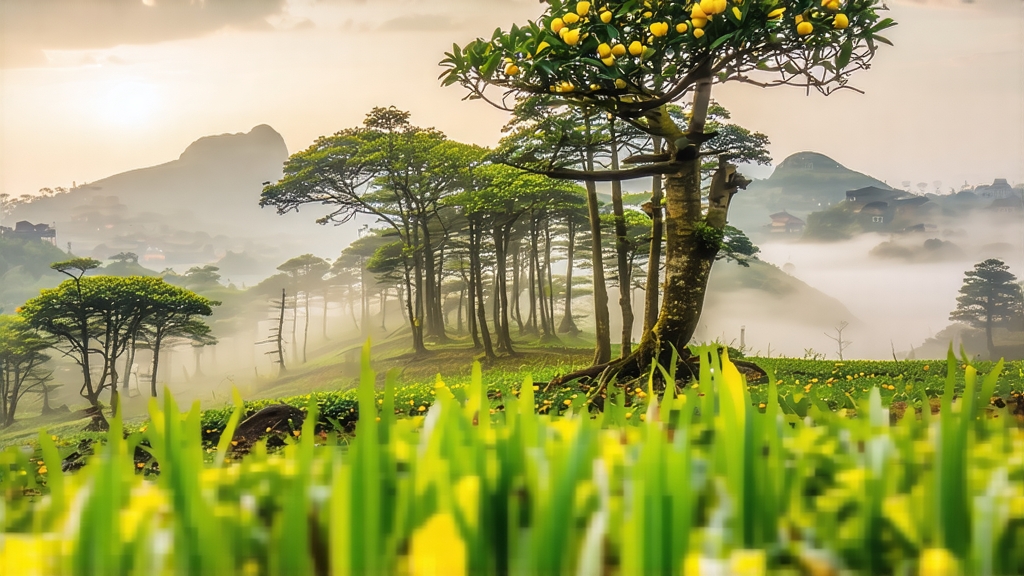
High on Mengding Mountain, where Sichuan’s mist meets the sky, a tea once reserved for emperors still unfurls its tiny golden buds every early spring. Mengding Huangya—literally “Yellow Bud of Mengding”—is the oldest documented yellow tea, yet it remains the least known outside China. To understand why it was treasured by Tang-dynasty poets, Song court officials, and Qing caravan traders alike, one must follow the leaf from mist-shrouded garden to gaiwan, from ancient tribute list to modern cup.
History wrapped in mountain mist
Mengding Shan, rising 1 450 m above the Chengdu plain, was crowned “the foremost Buddhist mountain in the world” during the Eastern Han period. Monks planted tea as early as 53 BCE, and by the Tang dynasty (618-907 CE) the mountain’s tender buds were already freighted down the Min River to Chang’an, packed in bamboo tubes lined with camphor leaves to keep their fragrance. The Song emperor Huizong, himself a skilled tea connoisseur, decreed in 1115 that only buds picked before Qingming festival could enter the palace; any leaf touched by rain was rejected. Thus Mengding Huangya became one of the earliest examples of a “pre-Qingming” tribute tea, a status it held for eight centuries. When the Qing turned to darker, more durable bricks for their horse-caravan trade, yellow tea’s complicated craft declined; by the 1950s fewer than 30 kg were produced annually. The 2008 intangible-cultural-heritage listing revived interest, and today a handful of families still guard the secret of “sealed yellowing,” the micro-fermentation step that gives the tea its luminous color and mellow sweetness.
Micro-terroir in a single ridge
Mengding’s unique ecology is inseparable from the tea’s character. The mountain sits at the seam between the Sichuan basin’s humid subtropical air and the Tibetan plateau’s cool drafts. Night temperatures can drop 15 °C within hours, forcing the tea bush to convert starch into soluble sugars for frost protection. The soil is a crumbly quartz-rich yellow loam, slightly acidic (pH 4.9–5.2) and laced with manganese and zinc washed down from Jurassic sandstone. Indigenous cultivars—mainly the small-leaf “Mengding zao” and the purple-veined “Mengding zi”—have adapted to this stress by producing extra linalool and geraniol, the same aromatics found in lavender and rose. The result is a leaf that smells of mountain orchid even before it is heated.
Craft: the art of letting the leaf suffocate gently
Yellow tea is often mis-described as “green tea with an extra step.” In reality the additional phase, men huang (“sealed yellowing”), is a delicate act of controlled suffocation that can last 24–72 h and decides everything. The process begins at 3 a.m. when pickers climb the ridge by torchlight to gather only the unopened bud and its first unfolding leaf, standard “one bud, one leaf, 2.5 cm length.” The pluck must reach the farmhouse within two hours; any delay oxidises the cuticle and ruins the jade colour.
Fixation: 4 min in a 160 °C wok
The leaves are hand-tossed in a cast-iron wok whose surface has been rubbed with fresh ginger to reduce static cling. The goal is not full de-enzyming as in green tea; polyphenol oxidase must be left at 12–15 % activity so that later yellowing can proceed.
Rolling: 8 min under 2 kg pressure
A bamboo roller presses the buds just enough to break 30 % of cell walls, releasing amino acids without shredding the leaf. The sap coats the surface, preparing the groundwork for the slow auto-oxidation to come.
First drying: 40 °C for 20 min
The leaves are laid on horse-hair trays set above a pinewood charcoal brazier. Moisture drops to 45 %, and the leaf becomes leathery, ready for the critical step.
Sealed yellowing: the soul of Mengding Huangya
The partially dried buds are piled 5 cm deep inside oak boxes lined with wet cotton cloth. The boxes are slid into a cave-like room where temperature is held at 28 °C and relative humidity at 85 %. Over